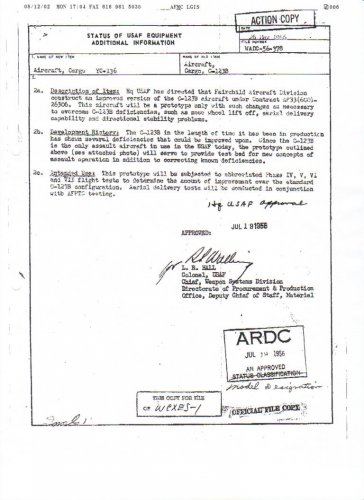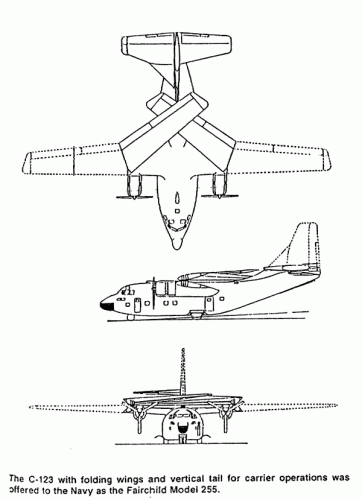I drafted the following off-line before I saw jcf's comment and Skyblazer's comment on that, but here is my thinking on the subject.
I have no doubt that the M-255. was a submission to meet the US Navy’s COD requirements that were eventually met by the Grumman TF-1. I have no idea what the other contenders were. The TF-1 appeared in 1955.
But I think it is unlikely that in 1956 a USAF designation would be used for a proposed US Navy aircraft. With the exception of the T-28, all USAF aircraft ‘adopted’ by the US Navy received US Navy designations, eg C-121 v R7V, C-130 v R8V, C-140 v UV and T-39 v T3J, the latter occurring in September 1961 and at a time that DoD designation were just around the corner.
The May 1956 request for the YC-136 is for a prototype aircraft to overcome deficiencies in the C-123B performance, such as nose-wheel lift-off, aerial delivery capability and directional stability problems. It is not clear how these shortcomings were to be overcome but there is a subtle hint in the various C-123 sub-types that were fitted with auxiliary jet engines that, perhaps, the C-123B was underpowered.
This resulted in YC-123H that was fitted with 2 General Electric CJ610 auxiliary engines to demonstrate improved performance as an assault transport. This aircraft (54-2956) was a C-123B converted on the production line in 1956 and was completed in 1957. Apart from the two jet engines it was fitted with a main gear landing track similar to the C-130A. All these adjustments allowed an increase in gross weight to 67,000 lb, compared to the 60,000 lb of the basic C-123B.
Also in 1957 Fairchild converted ten C-123Bs with 2 Fairchild J44-R-3 engines in the wingtip. These were used as support aircraft for the DEW line installations.
Finally, a number of C-123B were fitted with jet boost engines in 1966 and redesignated as C-123K, another indication that the basic C-123B lacked power. It has been suggested that the YC-123H had been a prototype for the C-123K.
If I would be allowed to take a gamble, I would put my money on the YC-123H being the YC-136. It was not the first time that a new designation was abandoned in favour of an existing designation for funding purposes. The classic example is the F-96 v F-84F.
But, having stated my gamble, there is, to date, no evidence whatsoever that my gamble is correct.
References:
Swanborough, G. & Bowers, P., US Military Aircraft since 1909, p.318
Adock, A., C-123 Provider In Action, p.27


